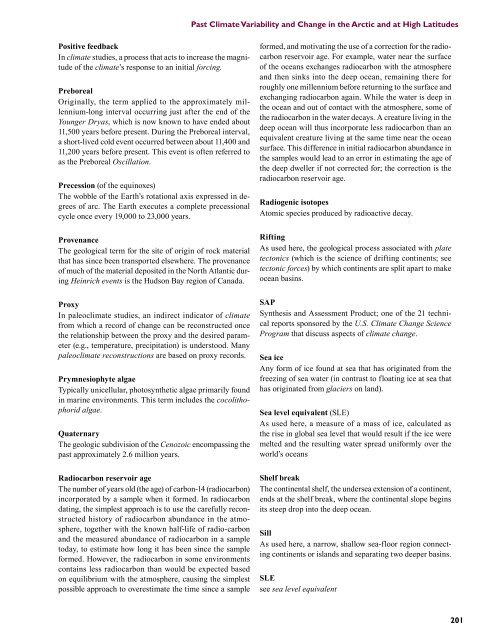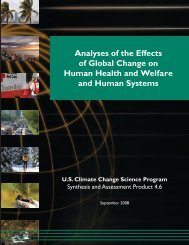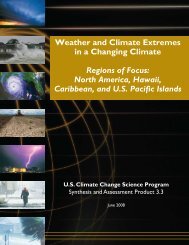Past Climate Variability and Change in the Arctic and at High Latitudes
Past Climate Variability and Change in the Arctic and at High Latitudes
Past Climate Variability and Change in the Arctic and at High Latitudes
Create successful ePaper yourself
Turn your PDF publications into a flip-book with our unique Google optimized e-Paper software.
Positive feedback<br />
In clim<strong>at</strong>e studies, a process th<strong>at</strong> acts to <strong>in</strong>crease <strong>the</strong> magnitude<br />
of <strong>the</strong> clim<strong>at</strong>e’s response to an <strong>in</strong>itial forc<strong>in</strong>g.<br />
Preboreal<br />
Orig<strong>in</strong>ally, <strong>the</strong> term applied to <strong>the</strong> approxim<strong>at</strong>ely millennium-long<br />
<strong>in</strong>terval occurr<strong>in</strong>g just after <strong>the</strong> end of <strong>the</strong><br />
Younger Dryas, which is now known to have ended about<br />
11,500 years before present. Dur<strong>in</strong>g <strong>the</strong> Preboreal <strong>in</strong>terval,<br />
a short-lived cold event occurred between about 11,400 <strong>and</strong><br />
11,200 years before present. This event is often referred to<br />
as <strong>the</strong> Preboreal Oscill<strong>at</strong>ion.<br />
Precession (of <strong>the</strong> equ<strong>in</strong>oxes)<br />
The wobble of <strong>the</strong> Earth’s rot<strong>at</strong>ional axis expressed <strong>in</strong> degrees<br />
of arc. The Earth executes a complete precessional<br />
cycle once every 19,000 to 23,000 years.<br />
Provenance<br />
The geological term for <strong>the</strong> site of orig<strong>in</strong> of rock m<strong>at</strong>erial<br />
th<strong>at</strong> has s<strong>in</strong>ce been transported elsewhere. The provenance<br />
of much of <strong>the</strong> m<strong>at</strong>erial deposited <strong>in</strong> <strong>the</strong> North Atlantic dur<strong>in</strong>g<br />
He<strong>in</strong>rich events is <strong>the</strong> Hudson Bay region of Canada.<br />
Proxy<br />
In paleoclim<strong>at</strong>e studies, an <strong>in</strong>direct <strong>in</strong>dic<strong>at</strong>or of clim<strong>at</strong>e<br />
from which a record of change can be reconstructed once<br />
<strong>the</strong> rel<strong>at</strong>ionship between <strong>the</strong> proxy <strong>and</strong> <strong>the</strong> desired parameter<br />
(e.g., temper<strong>at</strong>ure, precipit<strong>at</strong>ion) is understood. Many<br />
paleoclim<strong>at</strong>e reconstructions are based on proxy records.<br />
Prymnesiophyte algae<br />
Typically unicellular, photosyn<strong>the</strong>tic algae primarily found<br />
<strong>in</strong> mar<strong>in</strong>e environments. This term <strong>in</strong>cludes <strong>the</strong> cocolithophorid<br />
algae.<br />
Qu<strong>at</strong>ernary<br />
The geologic subdivision of <strong>the</strong> Cenozoic encompass<strong>in</strong>g <strong>the</strong><br />
past approxim<strong>at</strong>ely 2.6 million years.<br />
Radiocarbon reservoir age<br />
The number of years old (<strong>the</strong> age) of carbon-14 (radiocarbon)<br />
<strong>in</strong>corpor<strong>at</strong>ed by a sample when it formed. In radiocarbon<br />
d<strong>at</strong><strong>in</strong>g, <strong>the</strong> simplest approach is to use <strong>the</strong> carefully reconstructed<br />
history of radiocarbon abundance <strong>in</strong> <strong>the</strong> <strong>at</strong>mosphere,<br />
toge<strong>the</strong>r with <strong>the</strong> known half-life of radio-carbon<br />
<strong>and</strong> <strong>the</strong> measured abundance of radiocarbon <strong>in</strong> a sample<br />
today, to estim<strong>at</strong>e how long it has been s<strong>in</strong>ce <strong>the</strong> sample<br />
formed. However, <strong>the</strong> radiocarbon <strong>in</strong> some environments<br />
conta<strong>in</strong>s less radiocarbon than would be expected based<br />
on equilibrium with <strong>the</strong> <strong>at</strong>mosphere, caus<strong>in</strong>g <strong>the</strong> simplest<br />
possible approach to overestim<strong>at</strong>e <strong>the</strong> time s<strong>in</strong>ce a sample<br />
<strong>Past</strong> <strong>Clim<strong>at</strong>e</strong> <strong>Variability</strong> <strong>and</strong> <strong>Change</strong> <strong>in</strong> <strong>the</strong> <strong>Arctic</strong> <strong>and</strong> <strong>at</strong> <strong>High</strong> L<strong>at</strong>itudes<br />
formed, <strong>and</strong> motiv<strong>at</strong><strong>in</strong>g <strong>the</strong> use of a correction for <strong>the</strong> radiocarbon<br />
reservoir age. For example, w<strong>at</strong>er near <strong>the</strong> surface<br />
of <strong>the</strong> oceans exchanges radiocarbon with <strong>the</strong> <strong>at</strong>mosphere<br />
<strong>and</strong> <strong>the</strong>n s<strong>in</strong>ks <strong>in</strong>to <strong>the</strong> deep ocean, rema<strong>in</strong><strong>in</strong>g <strong>the</strong>re for<br />
roughly one millennium before return<strong>in</strong>g to <strong>the</strong> surface <strong>and</strong><br />
exchang<strong>in</strong>g radiocarbon aga<strong>in</strong>. While <strong>the</strong> w<strong>at</strong>er is deep <strong>in</strong><br />
<strong>the</strong> ocean <strong>and</strong> out of contact with <strong>the</strong> <strong>at</strong>mosphere, some of<br />
<strong>the</strong> radiocarbon <strong>in</strong> <strong>the</strong> w<strong>at</strong>er decays. A cre<strong>at</strong>ure liv<strong>in</strong>g <strong>in</strong> <strong>the</strong><br />
deep ocean will thus <strong>in</strong>corpor<strong>at</strong>e less radiocarbon than an<br />
equivalent cre<strong>at</strong>ure liv<strong>in</strong>g <strong>at</strong> <strong>the</strong> same time near <strong>the</strong> ocean<br />
surface. This difference <strong>in</strong> <strong>in</strong>itial radiocarbon abundance <strong>in</strong><br />
<strong>the</strong> samples would lead to an error <strong>in</strong> estim<strong>at</strong><strong>in</strong>g <strong>the</strong> age of<br />
<strong>the</strong> deep dweller if not corrected for; <strong>the</strong> correction is <strong>the</strong><br />
radiocarbon reservoir age.<br />
Radiogenic isotopes<br />
Atomic species produced by radioactive decay.<br />
Rift<strong>in</strong>g<br />
As used here, <strong>the</strong> geological process associ<strong>at</strong>ed with pl<strong>at</strong>e<br />
tectonics (which is <strong>the</strong> science of drift<strong>in</strong>g cont<strong>in</strong>ents; see<br />
tectonic forces) by which cont<strong>in</strong>ents are split apart to make<br />
ocean bas<strong>in</strong>s.<br />
SAP<br />
Syn<strong>the</strong>sis <strong>and</strong> Assessment Product; one of <strong>the</strong> 21 technical<br />
reports sponsored by <strong>the</strong> U.S. <strong>Clim<strong>at</strong>e</strong> <strong>Change</strong> Science<br />
Program th<strong>at</strong> discuss aspects of clim<strong>at</strong>e change.<br />
Sea ice<br />
Any form of ice found <strong>at</strong> sea th<strong>at</strong> has orig<strong>in</strong><strong>at</strong>ed from <strong>the</strong><br />
freez<strong>in</strong>g of sea w<strong>at</strong>er (<strong>in</strong> contrast to flo<strong>at</strong><strong>in</strong>g ice <strong>at</strong> sea th<strong>at</strong><br />
has orig<strong>in</strong><strong>at</strong>ed from glaciers on l<strong>and</strong>).<br />
Sea level equivalent (SLE)<br />
As used here, a measure of a mass of ice, calcul<strong>at</strong>ed as<br />
<strong>the</strong> rise <strong>in</strong> global sea level th<strong>at</strong> would result if <strong>the</strong> ice were<br />
melted <strong>and</strong> <strong>the</strong> result<strong>in</strong>g w<strong>at</strong>er spread uniformly over <strong>the</strong><br />
world’s oceans<br />
Shelf break<br />
The cont<strong>in</strong>ental shelf, <strong>the</strong> undersea extension of a cont<strong>in</strong>ent,<br />
ends <strong>at</strong> <strong>the</strong> shelf break, where <strong>the</strong> cont<strong>in</strong>ental slope beg<strong>in</strong>s<br />
its steep drop <strong>in</strong>to <strong>the</strong> deep ocean.<br />
Sill<br />
As used here, a narrow, shallow sea-floor region connect<strong>in</strong>g<br />
cont<strong>in</strong>ents or isl<strong>and</strong>s <strong>and</strong> separ<strong>at</strong><strong>in</strong>g two deeper bas<strong>in</strong>s.<br />
SLE<br />
see sea level equivalent<br />
201




